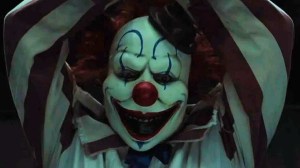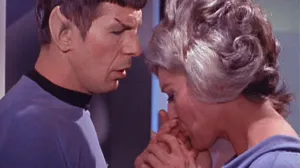Given the record-breaking commercial success of Andy Muschietti’s two-part IT adaptation, it was only a matter of time before Warner Bros. Discovery tried to make some extra money with the franchise. The opportunity arose when Muschietti, together with producer Barbara Muschietti and actor Jason Fuchs, developed a prequel series based on Pennywise’s (Bill Skarsgård) origins and his long reign of terror in Derry. IT: Welcome to Derry arrives as an eight-part story that fulfills most of the promises of its intriguing premise, explaining how Pennywise became a major threat to children in Derry and exploring how the Dancing Clown terrified the town in previous cycles. However, the five episodes available to critics before the series premiere also showcase how the series carries over some of the biggest problems from the movies, especially IT: Chapter 2.
Videos by ComicBook.com
Set mostly in 1962, IT: Welcome to Derry unfolds during one of Pennywise’s hunting cycles. Every 27 years, the creature awakens from a long slumber, terrorizing children who it then kidnaps and drags into the sewers, to quell its hunger for fear and flesh. As expected, Welcome to Derry features a new Losers’ Club, as outcast children band together to try to survive the creatures’ attacks once they become unfortunate targets. Furthermore, the series also follows a secret military operation set in Derry’s outskirts, which slowly overlaps with the history of Pennywise.
For most of the series’ runtime, at least in the episodes we watched, Welcome to Derry‘s dual storyline remains mostly disconnected. There are some points of contact between the military and the children, but each narrative core works as a separate thread. Unfortunately, that makes it more obvious how many of them are more interesting than the other, and it’s not the one you would expect.
Rating: 3 out of 5
| PROS | CONS |
| Strong adult storyline with rich 1960s social and political context | Overreliance on CGI-driven set pieces that dull the horror |
| Excellent performances overall | Underdeveloped children’s storyline |
| Expands Pennywise’s mythology and connects cleverly to The Shining | Missed opportunities to explore intriguing character backstories |
| Impressive production design and period atmosphere | Uneven pacing and disconnected dual narratives |
IT: Welcome to Derry Makes the Adults Interesting

One of the main criticisms of IT: Chapter 2, reflected in its diminishing box office returns and lower critical score, is that the adults were less interesting to follow than the children. That was not due to lack of talent, as the movie featured an all-star cast that included heavy hitters such as James McAvoy, Jessica Chastain, and Bill Hader. Still, the dynamics between the adults was just a pale echo of the children’s cast, the true heart of the first movie. It also didn’t help the sequel that the adults were not given much to do, just blindly strolling through Derry before their showdown against Pennywise.
IT: Welcome to Derry fixes this by allowing its adult cast to have their own goals to reach and perils to overcome. The series brilliantly taps into the anxieties of the early 1960s, reflecting the nuclear fear on the rise just before the Cuban Missile Crisis, at the climax of the Cold War. Plus, with Jim Crow laws still imposing racial segregation in the Southern states, and Northern states still learning how to handle the tension between ingrained racism and equal rights to Black people, Derry becomes a powder keg of fear and distrust, a banquet for a creature such as Pennywise. Finally, Welcome to Derry also puts Derry’s Native American community front and center, fixing a misguided decision of IT: Chapter Two by giving them a voice to fight prejudice. All these elements become part of the story naturally, mixing social questions and paranormal threats in a way that will certainly make Stephen King proud.

The adult storyline is also the throughline to learn more about the creature’s arrival in Derry and the supernatural rules that guide its actions, bringing novelty to the world of IT. Plus, Welcome to Derry‘s teased connections to King’s larger horror universe are all tied to the structural racism of the town and the military operation, with The Shining‘s Dick Halloran (Chris Chalk) playing a major role. Chalk, by the way, is perfectly cast as Halloran, adding new layers to a character that only passes by The Shining while being easily recognizable in the part. On that note, casting is one of Welcome to Derry‘s biggest strengths, with Jovan Adepo’s Major Leroy Hanlon, Taylour Paige as his wife Charlotte, Kimberly Norris Guerrero as Rose, and James Remar as General Francis Shaw all deserving to be singled out.
The New Losers’ Club Is IT: Welcome to Derry‘s Least Interesting Aspect

As surprising as it may be, the children’s half of IT: Welcome to Derry‘s storyline is the series’ least engaging aspect. This can be partly explained by how the new Losers’ Club is basically rehashing the same journey we already watched in the first movie. Also, since Pennywise is still around and unharmed by the late 1980s, we know these new children won’t be able to become a serious threat to the creature, which reduces the stakes of the prequel. In addition, the serialized structure means that some characters will depart from some episodes, with newcomers arriving later. That means we don’t see as much as we should of the fantastic acting the young cast delivers. However, the biggest issue with the children’s storyline is how Welcome to Derry puts spectacle ahead of character.
The children’s storyline mostly serves to justify set pieces that are just not that interesting. While a good chunk of the first movie was dedicated to Pennywise’s terrifying presence and his growing stalking of his prey, IT: Chapter Two shifted the focus to bombastic attacks that sometimes became unintentionally funny due to its heavy leaning into CGI. That approach is again part of the story, as IT: Welcome to Derry tries to one-up Pennywise’s appearances at each episode, a tactic that becomes less effective as time goes by. There’s a reason why practical effects are so valued in genre productions, and that’s because CGI rarely manages to capture the same level of texture and grit necessary for a fantastical situation to become credible — and thus, scary.

The overreliance on set pieces also gets in the way of the new Losers’ Club’s dynamics. In the first movie, many of the relationships between the child characters were pre-established, which helped to set things into motion. In the prequel series, however, almost all the children are getting to know each other. Still, there’s not enough time dedicated to them forming the bonds that would allow them to face Pennywise. It’s harder to believe the new Losers’ Club could trust each other with their lives, despite the extended runtime a TV show has in comparison to a movie.
What’s worse is that the child characters, as a whole, are interesting in themselves, but they are often underused. Lilly (Clara Stack) has had previous traumas that led her to be committed to a mental health institution, which the series teases could become an exploration of the dire situation of asylums in the 1960s, which never materializes. Rich’s (Arian S. Cartaya) background as a Latino of Cuban descent is also something that could have easily been tied to the adult storyline thematic worries, but it is not. Even Ronnie (Amanda Christine), perhaps the most central piece of the children’s journey, doesn’t have much time to show audiences what makes her character tick. That’s an utter waste of talent, as the entire young cast is phenomenal, and they are sacrificed for scares that mostly don’t land.

IT: Welcome to Derry is still an entertaining watch. The cast alone is a great reason to follow it, and everyone interested in Pennywise’s mythology will get some new nuggets of knowledge to chew upon each week. Nevertheless, part of the series’ potential is squandered by its attempt to go bigger all the time. The pacing of the series does improve after a few episodes, especially as the adult storyline picks up the pace, so there’s always the possibility that the three episodes that were not available for reviewers have even better things to show. Still, based on the first five episodes of the season, IT: Welcome to Derry has some major flaws that can’t be ignored.
IT: Welcome to Derry premieres on HBO on October 26, with new episodes dropping each Sunday.









